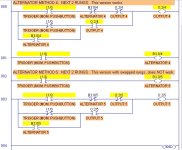Davek0974
Member
With the help of this forum, I had a plc replacement project signed off today, this is not my day job and haven't done plc stuff for about ten years, I re-used an AB SLC503 we had on the shelf.
The process was a step type printing one - Print, advance web, cut and repeat. There are options for the operator to just do the print alone or the advance, cut steps alone as well as various jog and batch control options.
The code was re-written as the first option was in-line and was becoming a bugger to debug. The newer version uses subroutines for each stage and the main ladder only has code for the cycle control, stop, start and safety monitor. Each subroutine is triggered by a latch and responds by triggering a latch when finished - this seemed to make a lot of sense to me.
The cycle control still had me playing for a while, today being a good example, I spent a few hours trying to figure out why a latch was not un-latching when the process was stopped at a certain point. It turned out it was unlatching but was immediately being re latched by another rung, it was just too fast to see.
Anyway it all worked out after a coffee
This got me to thinking of other ways to control cyclic machines - would a sequencer be better, easier? A counter maybe?
It's been a lot of fun so far, even more so as it works better now than it did when running on the original plc/program I have a possibility of three more to convert in the future.
I have a possibility of three more to convert in the future.
The process was a step type printing one - Print, advance web, cut and repeat. There are options for the operator to just do the print alone or the advance, cut steps alone as well as various jog and batch control options.
The code was re-written as the first option was in-line and was becoming a bugger to debug. The newer version uses subroutines for each stage and the main ladder only has code for the cycle control, stop, start and safety monitor. Each subroutine is triggered by a latch and responds by triggering a latch when finished - this seemed to make a lot of sense to me.
The cycle control still had me playing for a while, today being a good example, I spent a few hours trying to figure out why a latch was not un-latching when the process was stopped at a certain point. It turned out it was unlatching but was immediately being re latched by another rung, it was just too fast to see.
Anyway it all worked out after a coffee
This got me to thinking of other ways to control cyclic machines - would a sequencer be better, easier? A counter maybe?
It's been a lot of fun so far, even more so as it works better now than it did when running on the original plc/program





